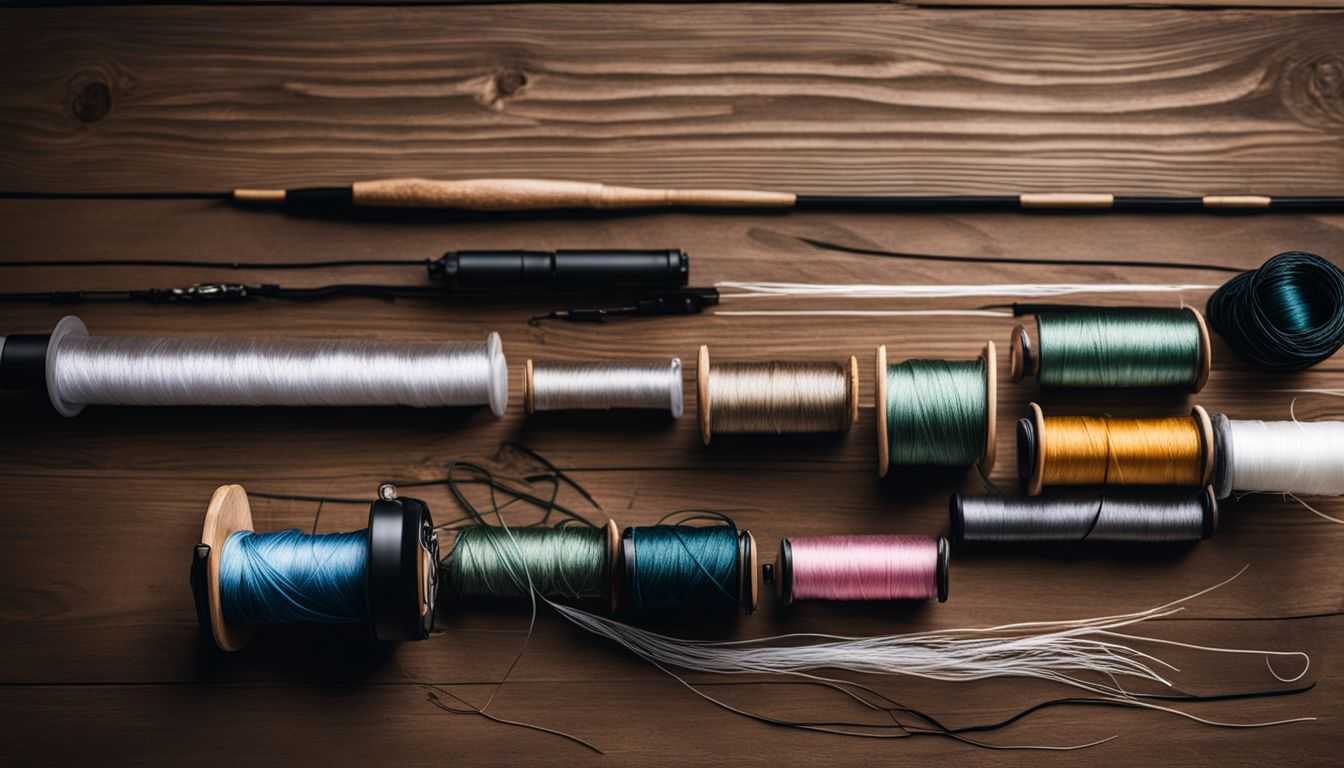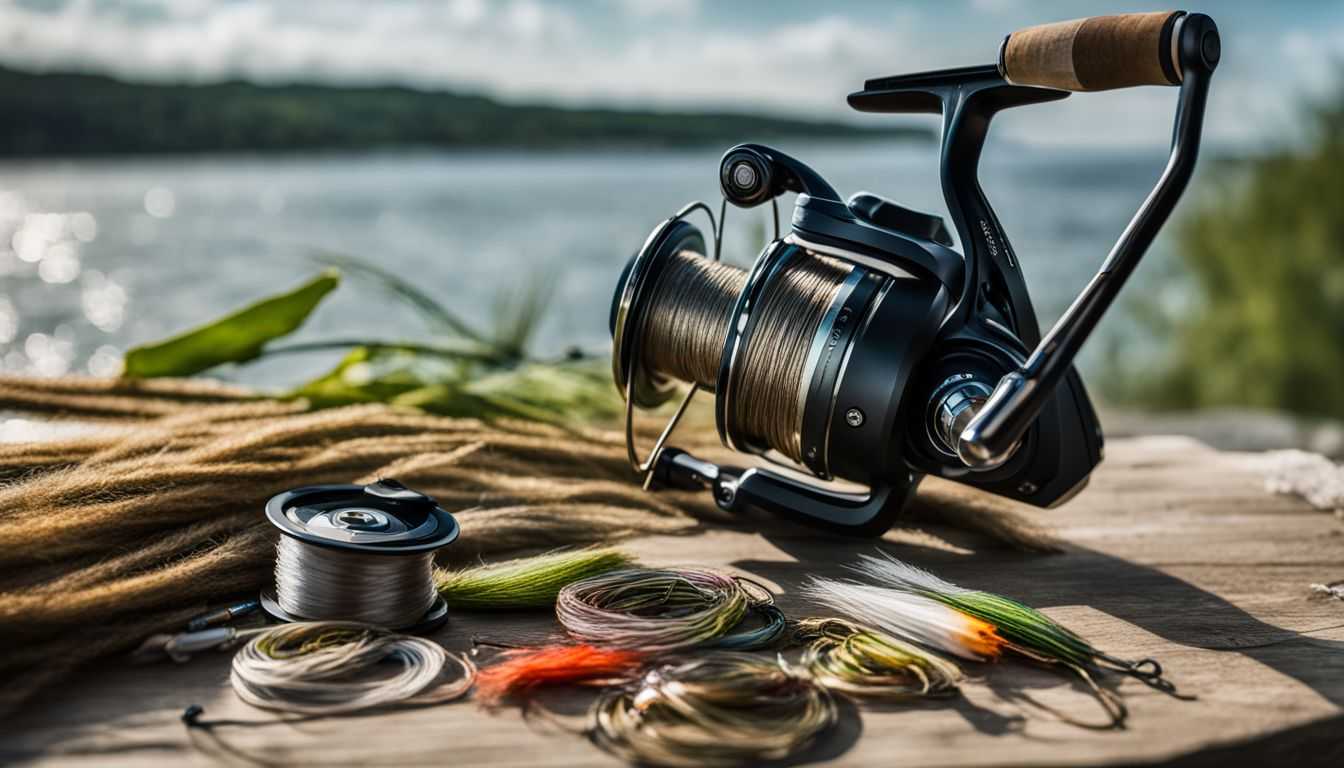Unraveling the mystery of which line to use for bass fishing can be quite a challenge. With numerous types such as monofilament, braided, and fluorocarbon each having their pros and cons, it’s easy to get overwhelmed.
This article breaks down these elements into simple terms, guiding you on how to land the best line for your angling adventures. Ready for a game-changing fishing experience? Dive in!
Key Takeaways
- There are three main types of fishing lines for bass fishing: monofilament, braided, and fluorocarbon.
- Factors to consider when choosing a fishing line include stretch, breaking strength, visibility, spool size, and cost.
- The best fishing lines for bass in 2022 include Seaguar Tatsu (premium fluorocarbon), Berkley Trilene 100% Fluorocarbon (everyday use fluorocarbon), Gamma High Performance Copolymer (copolymer line), Original Power Pro Spectra (everyday braided line), and Sufix Advance (premium monofilament line).
- To choose the best line for bass fishing, it’s important to understand the different types of lines and consider factors like stretch, breaking strength, visibility, spool size, and cost. Experimenting with different options will help you find what works best for you.
Understanding the Different Types of Fishing Lines

There are three main types of fishing lines to consider when bass fishing: monofilament, braided, and fluorocarbon.
Monofilament
Monofilament is a top pick for bass fishing. It’s made of a single fiber, which makes it versatile and easy to use. Anglers love it because it fits in the budget well. You can change your nylon fishing line with monofilament at any time too.
But you need to store this line away from sunlight for longer life. The right use of such lines brings much success in bass fishing!
Braided
The braided line is great for bass fishing. It does not stretch which makes it very strong and sensitive. You can feel small bites easily with this line. This sensitivity makes it a top pick for rough fishing too.
Tying knots with a braided line might be hard at first. But, its resistance to scrapes and cuts make up for it in tough spots where fish hide. The cost of braided lines is more than monofilament lines though.
Also, you will see this type of line floating on water during your fishing trip.
Fluorocarbon
Fluorocarbon is a top choice for many anglers. It’s almost invisible in water, which tricks the fish. Its strength and resistance to wear make it last long. It doesn’t stretch much, so you feel bites better.
This line works best in busy waters where bass see lots of hooks. Some find it hard to handle compared to monofilament but get used to it over time.
Factors to Consider When Choosing a Fishing Line for Bass

When choosing a fishing line for bass, it is important to consider factors such as stretch, breaking strength, visibility, spool size, and cost.
Stretch
Stretch is a crucial factor to think about when choosing a fishing line for bass. It refers to the line’s elasticity or how much it can stretch under tension. The amount of stretch in a fishing line can affect various aspects of your fishing experience, such as bite detection and hooking efficiency.
A braided line, for example, has no stretch, which allows for better hook sets and increased sensitivity. On the other hand, fluorocarbon lines have less stretch compared to monofilament lines and work well in clear water conditions.
By considering the stretch of your fishing line, you can improve your overall performance on the water and increase your chances of landing that trophy bass!
Breaking Strength
The breaking strength of a fishing line is an important factor to consider when choosing a line for bass fishing. It refers to the amount of weight or force that the line can withstand before it breaks.
Higher tensile strength lines, like 20-pound test line, are able to handle more shock when setting the hook compared to lighter lines, such as 8-pound test line. It’s important to choose a line with enough strength to handle the size and fight of bass you’re targeting.
Keep in mind that most fishing lines will break at a higher pound test than their rating suggests, so it’s always good to have some extra strength just in case.
Visibility
Visibility is a really important factor to consider when choosing the best fishing line for bass. Not all fishing lines are the same when it comes to visibility, so it’s crucial to choose one that works well in different water conditions.
The article emphasizes how knowing about fishing line visibility can greatly improve success in bass fishing. It plays a critical role in selecting the perfect fishing line for bass, as different levels of visibility can affect how easily fish can spot and detect the line.
So, anglers should evaluate this factor carefully when selecting a fishing line for bass to ensure the best chances of catching those big ones!
Spool Size
When choosing a fishing line for bass, don’t forget to consider the spool size. The spool size is important because it determines how much line can fit on your reel. If you choose a line with too large of a diameter or pound test, it might not fit properly on your spool.
On the other hand, if you choose a line that is too thin or light, it may not have enough strength to handle big bass. It’s recommended to keep the line size between 6- and 12-pound diameters when using braid to avoid it becoming unmanageable on a spool.
So, make sure to check the spool capacity and choose a fishing line that fits properly for optimal performance in catching bass!
Cost
The cost of the fishing line is an important factor to consider when choosing one for bass fishing. Higher quality lines tend to be more expensive, so anglers should take their budget into account.
The price of the fishing line can vary depending on its type and brand. Ultimately, the best fishing line for bass fishing will depend on an angler’s personal preferences and fishing style, including their willingness to invest in a higher cost line.
Keep in mind that affordability is also crucial, as different lines offer various features at different price points.
The Best Fishing Lines for Bass of 2022
Here are top fishing lines for bass in 2022: Seaguar Tatsu as the premium fluorocarbon line, Berkley Trilene 100% Fluorocarbon for everyday use, Gamma High Performance Copolymer as the copolymer line choice, Original Power Pro Spectra for everyday braided line, and Sufix Advance as the premium monofilament line.
Premium Fluorocarbon Line: Seaguar Tatsu
Seaguar Tatsu is one of the best fluorocarbon lines for bass fishing. It’s known for being super soft and easy to handle, making it a favorite among anglers. This line offers excellent invisibility, which means that fish won’t see it easily underwater.
It’s also incredibly strong and has limited stretch, so you can count on it to withstand the fight with big bass. Another advantage of Seaguar Tatsu is its abrasion resistance, which makes it perfect for fishing in tough conditions.
Overall, if you’re looking for a premium fluorocarbon line that performs exceptionally well and provides a virtually invisible presentation, Seaguar Tatsu is an excellent choice for your bass fishing needs.
Everyday Use Fluorocarbon Line: Berkley Trilene 100% Fluorocarbon
Looking for a tough and durable fishing line for bass? Look no further than the Berkley Trilene 100% Fluorocarbon Line. It is recommended as one of the best fishing lines for bass in 2022.
This line is known for its strong knot strength, making it perfect for finesse fishing techniques. Plus, it’s designed to be connected to a braided main line, giving you added versatility on the water.
Whether you’re casting or flipping, this high-grade quality line has got you covered.
Copolymer Line: Gamma High Performance Copolymer
The Gamma High Performance Copolymer is one of the best fishing lines for bass in 2022. It combines the easy handling of monofilament with even more strength. This line has superior knot strength, so you don’t have to worry about it breaking when you’re reeling in a fish.
The GAMMA processing gives this line ultra sensitivity and high strength, making it perfect for drop-shot fishing. So if you’re looking for a reliable and strong line for bass fishing, the Gamma High Performance Copolymer is a great choice.
Everyday Braided Line: Original Power Pro Spectra
The Original Power Pro Spectra is an excellent choice for anglers looking for an everyday braided line. This fishing line is made from ultra-strong braided Spectra Fiber, which makes it durable and reliable.
PowerPro uses Enhanced Body Technology to create a round and ultrasensitive line that allows you to feel every nibble and bite. It comes in a range of sizes and colors, giving you options to match your preferences and fishing conditions.
Plus, the Power Pro Spectra is value-priced, offering proven performance without breaking the bank. Whether you’re casting or reeling, this braided line will provide the strength and sensitivity you need for successful bass fishing adventures.
Premium Monofilament Line: Sufix Advance
The Sufix Advance Monofilament Line is a high-quality and durable fishing line that is highly recommended for bass fishing. Its smooth and even line lay, along with its resistance to kinking, ensures that you have a reliable and long-lasting line.
The Sufix Advance also has excellent knot strength, making it easy for you to tie strong knots. With precision winding and strong performance, the Sufix Advance Monofilament Line is considered one of the top fishing lines for bass in 2022.
Final Thoughts: How to Choose the Best Line for Bass Fishing
When it comes to choosing the best line for bass fishing, there are a few important factors to consider. Understanding the different types of fishing lines, such as monofilament, braided, and fluorocarbon, is key.
You’ll also want to think about things like stretch, breaking strength, visibility, spool size, and cost. While there isn’t one line that’s perfect for every situation, by taking these factors into account and considering your personal preferences and fishing conditions, you can find the best line for bass fishing that suits your needs.
Happy fishing!
Conclusion
In conclusion, choosing the best line for bass fishing is crucial for success on the water. By understanding the different types of lines and considering factors like stretch, breaking strength, visibility, spool size, and cost, anglers can make an informed decision.
Whether it’s a premium fluorocarbon line or an everyday braided line, selecting the right fishing line will greatly improve your chances of catching more bass. So take your time to research and experiment with different options to find what works best for you in different fishing conditions and techniques.
Happy angling!
FAQs
1. What type of fishing line is best for bass fishing?
A monofilament or fluorocarbon fishing line is commonly used for bass fishing due to its strength and durability.
2. How do I choose the right pound test for my bass fishing line?
The pound test refers to the maximum amount of weight a fishing line can handle. For bass fishing, a 10-20 pound test line is typically recommended.
3. Should I use braided or monofilament line for bass fishing?
Both braided and monofilament lines can be used for bass fishing, but it ultimately depends on personal preference and specific fishing conditions.
4. Can I use a heavier line for catching big bass?
Using a heavier line can help you reel in bigger and stronger bass without the fear of breaking your line.
5. How often should I change my bass fishing line?
It’s recommended to change your bass fishing line at least once per season or whenever you notice signs of wear and tear such as fraying or weak spots in the line.
